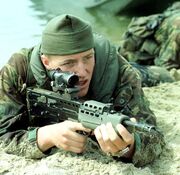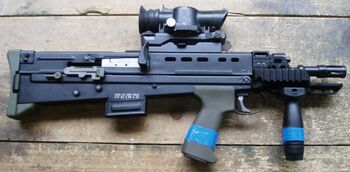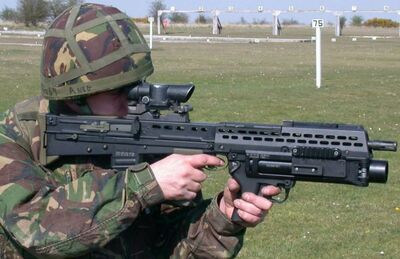Tags: Visual edit apiedit |
m (Spelling and Hyperlink Fix) Tags: Visual edit apiedit |
||
| Line 8: | Line 8: | ||
442 mm (17.4 in) (L22A1)|cartridge = 5.56×45mm NATO|action = Gas-operated, rotating bolt|rate_of_fire = 610-775 rounds/min|muzzle_velocity = 940 m/s (3,084 ft/s) (L85A2 & L98A2) |
442 mm (17.4 in) (L22A1)|cartridge = 5.56×45mm NATO|action = Gas-operated, rotating bolt|rate_of_fire = 610-775 rounds/min|muzzle_velocity = 940 m/s (3,084 ft/s) (L85A2 & L98A2) |
||
970 m/s (3,182.4 ft/s) (L86A2 LSW)|effective_firing_range = 600 m effective range used by one soldier. Effective at 800 m as a section using the LDS (lightweight day sight)|maximum_firing_range = 1000m (L86A2)|feed_system = 30-round detachable STANAG magazine |
970 m/s (3,182.4 ft/s) (L86A2 LSW)|effective_firing_range = 600 m effective range used by one soldier. Effective at 800 m as a section using the LDS (lightweight day sight)|maximum_firing_range = 1000m (L86A2)|feed_system = 30-round detachable STANAG magazine |
||
| − | 30-round detachable polymer Magpul EMAG|standard_sights = Telescopic SUSAT, ACOG and ELCAN LDS scopes, aperture iron sights}}The '''Enfield L85''' (also known as SA-80) is a family of standard issue weapons used by the [[British Armed Forces]] and [[Jamaican Defence Force]]. All weapons in the SA80 (Small Arms for the 1980s) range uses the 5.56mm Nato round. |
+ | 30-round detachable polymer Magpul EMAG|standard_sights = Telescopic SUSAT, ACOG and ELCAN LDS scopes, aperture iron sights}}The '''Enfield L85''' (also known as SA-80) is a family of standard issue weapons used by the [[British Armed Forces]] and [[Jamaica Defence Force|Jamaican Defence Force]]. All weapons in the SA80 (Small Arms for the 1980s) range uses the 5.56mm Nato round. |
==Production== |
==Production== |
||
| − | The development of the SA80 (Small Arms for 1980s) system, which included two weapons - SA80 IW (Infantry Weapon) assault rifle and SA80 LSW (Light Support Weapon) light machine gun, began in the late 1960s when British army decided to develop a new rifle, which will eventually replace the venerable 7.62mm L1 SLR (British-made [[FN FAL]] rifle) in the 1980s.[[File:Sa80 man.jpg|thumb|A British Royal Marines Commando armed with an L85A1]]When NATO trials were announced in 1977 to select a new cartridge, British state-owned Enfield Small Arms Factory developed its own small-caliber, high velocity round, which was more or less representing the US .223/5.56mm case necked down to accept 4.85mm (0.19 inch) bullet. When cartridge came out, Royal Small Arms Factory at Enfield developed a new weapon around it, initially designated as SA80-IW or XL65. This weapon, being somewhat similar in outline to the much earlier British [[Enfield EM-2]] assault rifle, was internally quite different, and, basically, was more or less the US-made [[Armalite AR-18]] rifle, put into bullpup stock and rechambered for 4.85mm cartridge. After NATO trials, which resulted in adoption of the Belgian SS-109 version of the 5.56mm cartridge, Enfield engineers rechambered XL65 for this cartridge and continued its development under the designation of XL70. Due to Falkland war new system was actually adopted only in 1984. Original SA80 weapons (both L85 and L86) were plagued with many problems, some being very serious. In general, L85 was quite unreliable and troublesome to handle and maintain, so, finally, in the year 1997, after years of constant complaints from the troops, it had been decided to upgrade most L85 rifles then in service. |
+ | The development of the SA80 (Small Arms for 1980s) system, which included two weapons - SA80 IW (Infantry Weapon) assault rifle and SA80 LSW (Light Support Weapon) light machine gun, began in the late 1960s when British army decided to develop a new rifle, which will eventually replace the venerable 7.62mm L1 SLR (British-made [[FN FAL]] rifle) in the 1980s.[[File:Sa80 man.jpg|thumb|A British Royal Marines Commando armed with an L85A1]]When NATO trials were announced in 1977 to select a new cartridge, British state-owned Enfield Small Arms Factory developed its own small-caliber, high velocity round, which was more or less representing the US .223/5.56mm case necked down to accept 4.85mm (0.19 inch) bullet. When cartridge came out, Royal Small Arms Factory at Enfield developed a new weapon around it, initially designated as SA80-IW or XL65. This weapon, being somewhat similar in outline to the much earlier British [[EM-2 rifle|Enfield EM-2]] assault rifle, was internally quite different, and, basically, was more or less the US-made [[ArmaLite AR-18|Armalite AR-18]] rifle, put into bullpup stock and rechambered for 4.85mm cartridge. After NATO trials, which resulted in adoption of the Belgian SS-109 version of the 5.56mm cartridge, Enfield engineers rechambered XL65 for this cartridge and continued its development under the designation of XL70. Due to Falkland war new system was actually adopted only in 1984. Original SA80 weapons (both L85 and L86) were plagued with many problems, some being very serious. In general, L85 was quite unreliable and troublesome to handle and maintain, so, finally, in the year 1997, after years of constant complaints from the troops, it had been decided to upgrade most L85 rifles then in service. |
| − | The upgrade program, committed in years 2000 - 2002, was completed by the famous Heckler&Koch, which was then owned by [[File:Sa80-l22a2.jpg|thumb|left|350px |
+ | The upgrade program, committed in years 2000 - 2002, was completed by the famous Heckler&Koch, which was then owned by [[File:Sa80-l22a2.jpg|thumb|left|350px|L22A2 carbine, as issued to [[Royal Armoured Corps]] tank crews in Iraq; note that it has a Picatinny rail above the front grip]]British Royal Ordnance company (German investors bought the HK back in the 2002). About 200 000 rifles were upgraded into the L85A2 configuration, out of total 320 000 or so original L85A1 rifles produced. While official reports about the upgraded weapons were glowing, the initial field reports from the British troops, engaged in the Afghanistan campaign of 2002, were unsatisfactory. Most problems, however, were traced to improper care and maintenance of weapons, and for now the L82A2 performs fairy well both in Afghanistan and Iraq. |
Other than the basic L85A1 variant, the SA80 IW also appeared in the shortened Carbine version, and in the manually operated L98A1 rifle, which got its gas system removed and a larger cocking handle attached. The L98A1 is used to train the army cadets for basic rifle handling and shooting skills, and the rifle is fired as a manually operated, straight pull magazine repeater rifle. The latest weapon in the SA80 family is the recently adopted L22 carbine, which is issued to tank crews of Royal Armoured Corps. This weapon is available in two versions, L82A1 and L82A2, the latter being fitted with additional Picatinny rail on the right side of front grip base. |
Other than the basic L85A1 variant, the SA80 IW also appeared in the shortened Carbine version, and in the manually operated L98A1 rifle, which got its gas system removed and a larger cocking handle attached. The L98A1 is used to train the army cadets for basic rifle handling and shooting skills, and the rifle is fired as a manually operated, straight pull magazine repeater rifle. The latest weapon in the SA80 family is the recently adopted L22 carbine, which is issued to tank crews of Royal Armoured Corps. This weapon is available in two versions, L82A1 and L82A2, the latter being fitted with additional Picatinny rail on the right side of front grip base. |
||
| Line 19: | Line 19: | ||
The current L85A2 rifles are recognized as reliable and very accurate, especially when using standard issue SUSAT telescope sights. The drawbacks of the L85A2 are somewhat poor balance (which can be improved with installation of HK-made 40mm underbarrel grenade launcher), right-side only extraction and rearward placement of the fire mode selector. |
The current L85A2 rifles are recognized as reliable and very accurate, especially when using standard issue SUSAT telescope sights. The drawbacks of the L85A2 are somewhat poor balance (which can be improved with installation of HK-made 40mm underbarrel grenade launcher), right-side only extraction and rearward placement of the fire mode selector. |
||
| − | === |
+ | ===Technical Description=== |
The L85 is a gas operated, magazine fed, selective fire rifle of bullpup layout. |
The L85 is a gas operated, magazine fed, selective fire rifle of bullpup layout. |
||
Revision as of 16:31, 29 May 2017
The Enfield L85 (also known as SA-80) is a family of standard issue weapons used by the British Armed Forces and Jamaican Defence Force. All weapons in the SA80 (Small Arms for the 1980s) range uses the 5.56mm Nato round.
Production
The development of the SA80 (Small Arms for 1980s) system, which included two weapons - SA80 IW (Infantry Weapon) assault rifle and SA80 LSW (Light Support Weapon) light machine gun, began in the late 1960s when British army decided to develop a new rifle, which will eventually replace the venerable 7.62mm L1 SLR (British-made FN FAL rifle) in the 1980s.

A British Royal Marines Commando armed with an L85A1
When NATO trials were announced in 1977 to select a new cartridge, British state-owned Enfield Small Arms Factory developed its own small-caliber, high velocity round, which was more or less representing the US .223/5.56mm case necked down to accept 4.85mm (0.19 inch) bullet. When cartridge came out, Royal Small Arms Factory at Enfield developed a new weapon around it, initially designated as SA80-IW or XL65. This weapon, being somewhat similar in outline to the much earlier British Enfield EM-2 assault rifle, was internally quite different, and, basically, was more or less the US-made Armalite AR-18 rifle, put into bullpup stock and rechambered for 4.85mm cartridge. After NATO trials, which resulted in adoption of the Belgian SS-109 version of the 5.56mm cartridge, Enfield engineers rechambered XL65 for this cartridge and continued its development under the designation of XL70. Due to Falkland war new system was actually adopted only in 1984. Original SA80 weapons (both L85 and L86) were plagued with many problems, some being very serious. In general, L85 was quite unreliable and troublesome to handle and maintain, so, finally, in the year 1997, after years of constant complaints from the troops, it had been decided to upgrade most L85 rifles then in service. The upgrade program, committed in years 2000 - 2002, was completed by the famous Heckler&Koch, which was then owned by

L22A2 carbine, as issued to Royal Armoured Corps tank crews in Iraq; note that it has a Picatinny rail above the front grip
British Royal Ordnance company (German investors bought the HK back in the 2002). About 200 000 rifles were upgraded into the L85A2 configuration, out of total 320 000 or so original L85A1 rifles produced. While official reports about the upgraded weapons were glowing, the initial field reports from the British troops, engaged in the Afghanistan campaign of 2002, were unsatisfactory. Most problems, however, were traced to improper care and maintenance of weapons, and for now the L82A2 performs fairy well both in Afghanistan and Iraq.
Other than the basic L85A1 variant, the SA80 IW also appeared in the shortened Carbine version, and in the manually operated L98A1 rifle, which got its gas system removed and a larger cocking handle attached. The L98A1 is used to train the army cadets for basic rifle handling and shooting skills, and the rifle is fired as a manually operated, straight pull magazine repeater rifle. The latest weapon in the SA80 family is the recently adopted L22 carbine, which is issued to tank crews of Royal Armoured Corps. This weapon is available in two versions, L82A1 and L82A2, the latter being fitted with additional Picatinny rail on the right side of front grip base.
The current L85A2 rifles are recognized as reliable and very accurate, especially when using standard issue SUSAT telescope sights. The drawbacks of the L85A2 are somewhat poor balance (which can be improved with installation of HK-made 40mm underbarrel grenade launcher), right-side only extraction and rearward placement of the fire mode selector.
Technical Description
The L85 is a gas operated, magazine fed, selective fire rifle of bullpup layout. The receiver of the L85 is made from stamped sheet steel, reinforced with welded and riveted machined steel inserts. The gas operated action has a short stroke gas piston, located above the barrel. The gas piston has its own return spring. Gas system has a three-positions gas regulator, one position for a normal firing, second for a firing in adverse conditions and the third for launching the rifle grenades (gas port is shut off). The machined bolt carrier rides inside the receiver on the two parallel steel guide rods, with the single return spring placed above and between the guide rods. The typical rotating bolt has 7 lugs that locks into the steel insert in the receiver, just behind the barrel breech. The charging handle is attached to the right side of the bolt carrier, and prior to A2 upgrade caused some problems by reflecting the ejected cases back into the action, thus causing stoppages. In the L85A2 configuration the charging handle was redesigned to avoid such problems. The charging handle slot is covered by the spring-loaded dust cover. The bolt and its extractor claw also were upgraded in the L85A2, to achieve more reliable extraction of the spent cases.
The trigger / hammer assembly of the L85A1 is also typical for a modern bullpup rifle, with the long link from the trigger to the hammer unit, located in the buttstock. The hammer

British soldier sights the L85A2 rifle fitted with German-made 40mm grenade launcher
assembly of the L85A2 was redesigned to introduce a slight delay before the hammer release when the gun is fired in the full auto. This did not affected the cyclic rate of fire but improved the reliability and stability of the weapon during the automatic fire. The fire mode selector is located at the left side of the receiver, well behind the magazine housing, and allows for single shots of full automatic modes of fire. The cross-bolt safety button is located above the trigger.
The barrel is rifled for a NATO-standard 5.56mm ammunition, with 1:7 twist, and is fitted with a NATO-standard flash hider, which allows to launch the rifle grenades from the barrel. The L85 is fed using NATO-standard (STANAG) magazines, similar to M16 type magazines, with the standard capacity of 30 rounds. Early L85A1 steel magazines caused a lot of troubles, as well as a magazine housing itself, which had a thin walls that could be easily dented, thus blocking the magazine way. Both magazines and its housings were upgraded in the L85A2 configuration. The standard sighting equipment is the 4X SUSAT (Sight Unit, Small Arms, Trilux) telescope, with illuminated reticle. The SUSAT is mounted on a quick-detachable mount at the top of the receiver, and features an emergency backup open sights at tits top. The SUSAT allows for an accurate fire (mostly in single shots) out to 400–500 meters. For a second-line troops an alternative sighting system is available, that consists of the removable front post sight with high base and post protection "ears", and a detachable carrying handle with built-in diopter rear sight. The L85 can be fitted with the proprietary knife-type multipurpose bayonet. L85A2 rifles also can be fitted with 40mm under-barrel grenade launcher, using special handguard. Launcher is made in Germany by Heckler-Koch.
L86 Light Support Weapon
The Enfield L86 LSW is a light support weapon created by Enfield in 1985 to replace the World War II-era Bren Light Machine Gun in the British Army, the L86 was based on the Enfield L85.
Description
The British Army's choice for squad automatic fire became the L86A1 'Light Support Weapon' in its 5.56x45mm NATO form, thus bringing to an end to the era of the popular World War II-era Bren Light Machine Gun series. The L86A1 was actually based on a modified version of the bull-pup Enfield L85 5.56mm rifle already in service with the army and in all actuality utilizes about 80% commonality in parts with the assault rifle version including the ability to fire from the same magazine.
Differences between the L85 assault rifle and the L86 LSW are subtle though the L86 is fielded with a heavier barrel with added length (effectively extending the range of the weapon past that of the rifle counterpart) that is more consistent with the sustained-fire squad automatic role. Additionally, a light-weight bipod is fitted to the near-front of the weapon for controlled firing and there are some modifications to the trigger mechanism as a whole. The L86A1 allows for single or automatic fire select modes. The new barrel assists in heat dissipation during full automatic fire which is important considering the barrel is not changeable on this system. A rear grip is added just behind the magazine and pistol-grip trigger for two-hand support. Optical sights on the L86A1 are also standard.
Operators
- Jamaica: Used since 1992.
- United Kingdom: In service
The original article can be found at Enfield L85 and the edit history here.